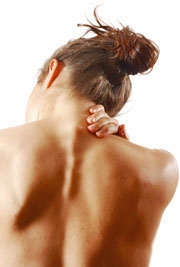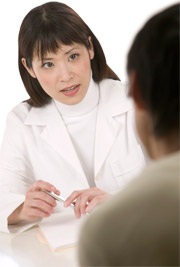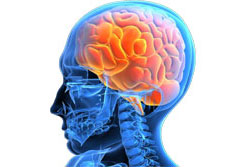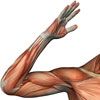- What is Cervical Dystonia (Spasmodic Torticollis)?
- Statistics
- Risk Factors
- Progression
- Symptoms
- Clinical Examination
- How is it Diagnosed
- Prognosis
- Treatment
- References
What is Cervical Dystonia (Spasmodic Torticollis)?

Cervical dystonia (CD) is the most common dystonia limited to one part of the body (focal or localised dystonia). CD describes dystonia that specifically occurs in the neck muscles. The condition is characterised by abnormal head posture, involuntary muscle contractions of the cervical spine, head tremor, sustained neck spasms and craniocervical pain.
People with dystonia may show a wide and diverse array of features that can include the following in varying degrees:
- Unusual posture, postural responses and postural control;
- Abnormal vestibular functioning;
- Altered perception of body orientation in space;
- Head jerking;
- “Sensory tricks” for relieving muscle tension (e.g. gently touching the face, neck or head at a specific place);
- Neck spasms and neck pain;
- Head rotation (twisting neck), including rotational torticollis and head tilt.
Almost all people with CD consider it to be a disability, predominantly due to the pain experienced as a result of muscle overactivity. Individuals with CD report that it has a significant negative impact on their quality of life.
In society, there is a lot of prejudice and stigmatisation associated with the condition, and as a result a large proportion of people with CD are depressed and socially withdrawn. Reports indicate that 25 to 40% of people with CD are unemployed due to their disability, which also contributes to their depression.
Statistics
Approximately nine out of 100,000 people will develop CD, making it the most common focal dystonia. Alternative diagnoses for CD may mean that this estimate is lower than the actual rate. The condition is more common in women; the female to male sex ratio is approximately 1.7:1.
CD most often begins during adulthood, with an average onset age of 42.9 years for women and 39.2 years for men.
It is very rare for children to develop cervical dystonia. If a child experiences twisting of the neck it is likely to be a similar but separate condition known as congenital torticollis. Congenital torticollis is present in some babies at birth. A muscle in the neck is shortened which causes their head to be tilted to the side. This condition can commonly be improved with physical therapy.
Some 5 to 21% of people with CD experienced trauma or injury to the neck or head before they experienced CD. However, this does not mean that these people contracted the condition as a result of the trauma. It is still largely unknown whether traumatic events cause the dystonia or act as a trigger for a dormant pre-existing condition. CD that occurs after brain or neck injury is clinically different from other forms of the condition. In particular, post-injury CD does not improve after sleep, and the head and neck tend to have a more limited range of motion.
Over 60% of persons with CD will need analgesics to manage the pain associated with the condition.
Progression

Primary cervical dystonia
CD is said to be primary when it is not a symptom associated with any other neurological (brain) condition but is a disorder on its own. The cause of primary CD is still largely unknown. Commonly people with CD will have a family history of movement disorders which suggests a genetic factor however no specific information on genes has been identified yet.
Secondary cervical dystonia
CD is said to be secondary when it is caused by other neurological conditions. There can be many different causes of secondary CD symptoms but whether they are truly causes of CD or simply triggers that activate the disorder remains to be determined. CD can evolve after the following physiological events or diseases:
- Neck or head injury – after the injury CD can occur immediately or up to 12 months after the event;
- CD can be a secondary symptom associated with Parkinsons disease and associated Parkinsonian disorders;
- CD can be a secondary symptom of Wilsons disease;
- Abnormal birth;
- Abnormal development history;
- Abnormalities present at birth such as abnormal head and neck shape are associated with the very rare cases of childhood CD;
- Exposure to toxins; or
- Use of older neuroleptics, anti-nausea medication or anti-vertigo medication.
How is it Diagnosed
The first step a doctor will take to diagnose CD is to obtain a detailed medical history, including any past trauma or injury and any balance issues. This will help to identify tardive dystonia caused by medications or toxins, which is the most common cause of CD. The doctor will ask you to describe your symptoms. Commonly, people with early CD complain of a stiff neck as well as involuntary twisting of the neck that feels like it is being “pulled”.
If the CD is primary, there are few options for further investigation, as laboratory tests and neuroimaging will not provide much more information.
During clinical examination, the overactive muscles involved in the postural abnormality will be identified by evaluating the range of motion and movement patterns of the head, neck and shoulders.
Prognosis

Around 10% of people will experience pain in the craniocervical region before the onset of dystonia symptoms. Once symptoms of CD begin, they will usually worsen for an average of 5 years before plateauing. 10-20% of people experience a reduction of symptoms, but they are highly likely to reoccur, sometimes even years later. In some people, the dystonia may spread beyond the craniocervical region.
Up to 75% of people with CD will at some stage experience widespread pain over the neck and shoulders. The pain is described as diffuse and exhausting, and branches out from the direction that the head is twisted. The degree of pain is related to the degree of muscle contraction and the spasms experienced.
It has been shown that stress can worsen the symptoms of CD. Therefore, people who feel self-conscious and stressed about their condition are likely to experience a more severe form of the illness. Physical activity and physical exertion are also shown to worsen symptoms.
A large proportion of people with CD report depression due to their disability and the disturbed body images associated with the condition. People with CD largely feel their social relationships are negatively affected, which in turn reduces their motivation to socialise.
Treatment
Early treatment is recommended, even with mild CD, as this may help prevent progression of the disorder.
Treatments for CD include botulinum toxin (BoNT) injections, oral medications, physical therapies, selective peripheral denervation, deep brain stimulationand social and supportive intervention. Botulinum toxin treatment is generally regarded as first-line treatment by most. The common CD condition, tardive dystonia is the most difficult form of CD to treat, as people usually respond very poorly to the available medications. The first course of action in these cases is to immediately stop using the medication that is causing the symptoms.
Botulinum toxin (BoNT)
BoNT is naturally occurring protein which exerts its clinical action (effects) by relaxing the muscle through the block of acetylcholine release at the neuromuscular junction. BoNT type A (BoNTA- Botox, Dysport) is the first-line treatment for CD patients. Positive results have been reported after even one injection cycle and these positive effects can be prolonged with further injections.
All people will respond differently to BoNTA injections. It is for this reason your doctor will want to monitor you throughout your therapy. When you first begin the treatment your doctor may want to change the dose or even the muscles injected, in order to optimise the results. Decisions about any changes needed for the next cycle of BoNTA injections may take several visits with your doctor. For the best response with this treatment it is important that you diligently and accurately report your symptoms to your doctor. It may be helpful to ask your family and friends to help observe you in order to achieve this.
BoNT is toxic and side effects can be developed when the toxin spreads. It is important to seek medical attention immediately if any difficulties in speech, breathing or swallowing occur. Your doctor will be able to advise if this treatment is appropriate for you.
Pharmacology
Oral agents do not provide much relief from symptoms of dystonia. Low dose benzodiazepines (Diazepam) are helpful as they help to relax the muscles and reduce anxiety. Baclofen (e.g. Baclo) acts to reduce the release of neurotransmitters which act to induce muscle activity. Both benzodiazepines and baclofen are associated with a relatively large amount of side effects.
Intrathecal baclofen
Intrathecal baclofen (e.g. Lioresal Intrathecal) injected in the high cervical spine has shown success in treating CD. After treatment, people have reported increased range of motion in the neck muscles, ease of care and improved quality of life. Common side-effects associated with baclofen include injection site reactions and medication related side-effects such as drowsiness, somnolence, dizziness, headache and nausea.
Selective peripheral denervation
Selective peripheral denervation is a procedure used only for treatment of CD. The treatment involves cutting the specific nerves that innervate the neck muscles affected in each case. This process is known as denervation, and leaves a feeling of numbness in the area, therefore reducing pain. This treatment is only used if BoNT or no other medications are effective. Selective peripheral denervation has been found to achieve promising immediate and long term results. Side effects as a result of the procedure are not common but include tic-like pain, a bacterial infection of the tissues that surround the tonsils (tonsillar abscess), transient swelling of the neck and a pins and needles’ sensation.
Deep brain stimulation (DBS)

DBS has the additional benefit of being an individualised treatment. Selection of target areas and different stimulation parameters can be varied according to the symptoms experienced.
DBS is associated with few side effects, generally seen in 2-8% of people. These include speech difficulties such as freezing of speech and worsening of voice intelligibility.
Physical therapy
Physical therapists will teach how to perform daily tasks in a way that minimises pain. They will also help develop techniques or sensory tricks to temporarily reduce dystonia. Many people find this effective, although the process by which it works is unknown. Neck bracing can be useful as a semi-permanent sensory trick. Physical therapists will also teach postural exercises that can help correct the cervical alignment.
EMG biofeedback helps people consciously control muscle tension by making them aware of the tension. Biofeedback has been successful in helping people with CD control their muscle tensions as much as possible. Studies have shown that biofeedback can reduce pain and disability up to 9 months after it is administered.
It is unclear whether physiotherapy exacerbates symptoms in people who are unable to relax their neck muscles. For people with CD whose symptoms worsen with physical stress, mobilising the muscles through physiotherapy may potentially cause more pain.
Lifestyle
Stress exacerbates the symptoms of CD so learning to manage your stress levels may be an effective way that you can control your condition. Try to relax and take deep breaths when you feel yourself tensing up. Physical therapists and psychologists can help you to develop further techniques that may help.
Social support is also an important part of CD therapy. Support groups can provide you with further information about the condition and it will give you a chance to talk to people that understand what you are going through.
Article kindly reviewed by:
Associate Professor Karl Ng MB BS (Hons I) FRCP FRACP PhD CCT Clinical Neurophysiology (UK) Consultant Neurologist – Sydney North Neurology and Neurophysiology (download referral form and map); Conjoint Associate Professor – Sydney Medical School, University of Sydney; and Editorial Advisory Board Member of the Virtual Neuro Centre.
More information
 |
For more information on neurological disorders that affect movement, and their treatments, see Neurological Rehabilitation and Movement Disorders. |
References
- Crowner BE. Cervical dystonia: Disease profile and clinical management. Phys Ther. 2007;87(11):1511-26. [Abstract | Full text]
- Stacy M. Epidemiology, clinical presentation, and diagnosis of cervical dystonia. Neurol Clin. 2008;26(Suppl 1):23-42. [Abstract]
- Harbo HF, Finsterer J, Baets J, et al. EFNS guidelines on the molecular diagnosis of neurogenetic disorders: General issues, Huntington’s disease, Parkinson’s disease and dystonias. Eur J Neurol. 2009;16(7):777-85. [Abstract]
- Vidailhet M, Grabli D, Roze E. Pathophysiology of dystonia. Curr Opin Neurol. 2009;22(4):406-13. [Abstract]
- Mller J, Wissel J, Kemmler G, et al. Craniocervical dystonia questionnaire (CDQ-24): Development and validation of a disease-specific quality of life instrument. J Neurol Neurosurg Psychiatry. 2004;75(5):749-53. [Abstract | Full text]
- Schwarz CS, Bressman SB. Genetics and treatment of dystonia. Neurol Clin. 2009;27(3):697-718. [Abstract]
- Wissel J, Ward AB, Erztgaard P, et al. European consensus table on the use of botulinum toxin type A in adult spasticity. J Rehabil Med. 2009;41(1):13-25. [Abstract | Full text]
- Lioresal Intrathecal [online]. St Leonards, NSW: MIMS Online; 1 July 2006 [cited 15 January 2010]. Available from: URL link
- Dillon A. Interventional procedure guidance 80: Selective peripheral denervation for cervical dystonia [online]. London: National Institute for Clinical Excellence; August 2004 [cited 15 May 2010]. Available from: URL link
- Albanese A, Barnes MP, Bhatia KP, et al. A systematic review on the diagnosis and treatment of primary (idiopathic) dystonia and dystonia plus syndromes: Report of an EFNS/MDS-ES Task Force. Eur J Neurol. 2006;13(5):433-44. [Abstract | Full text]
-
About dystonia: Related and differential disorders [online]. Chicago: Dystonia Medical Research Foundation; 2009 [cited 15 May 2010]. Available from: URL link
- Eken C, Gler V, Koparan C, icek M. Temporomandibular joint dislocation due to haloperidol induced acute dystonia: A case report and review of the literature. Erciyes Med J. 2009;(Supp 1):S10-3. [Abstract | Full text]
- Zesiewicz TA. Living with cervical dystonia: Improving quality-of-life outcomes with pharmacotherapy. Appl Neurol. 2007;(Suppl):2-8. [Full text]
- Product Information: Botox. Gordon, NSW: Allergan Australia Pty Ltd; 6 August 2009.
- Kaji R. Chapter 28: Dystonia. In: Hallet M (ed). Movement Disorders: Handbook of Clinical Neurophysiology, Volume 1. Amsterdam: Elsevier; 2003: 451-62. [Book]
- Jankovic J, Leder S, Warner D, et al. Cervical dystonia: clinical findings and associated movement disorders. Neurology. 1991; 41(7): 1088-91.
All content and media on the HealthEngine Blog is created and published online for informational purposes only. It is not intended to be a substitute for professional medical advice and should not be relied on as health or personal advice. Always seek the guidance of your doctor or other qualified health professional with any questions you may have regarding your health or a medical condition. Never disregard the advice of a medical professional, or delay in seeking it because of something you have read on this Website. If you think you may have a medical emergency, call your doctor, go to the nearest hospital emergency department, or call the emergency services immediately.







